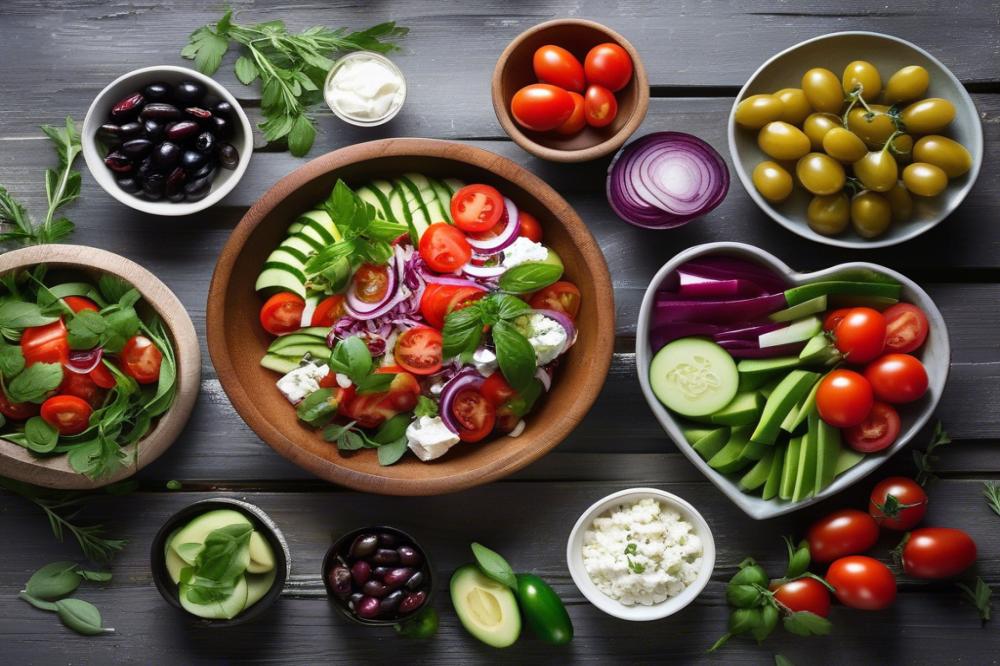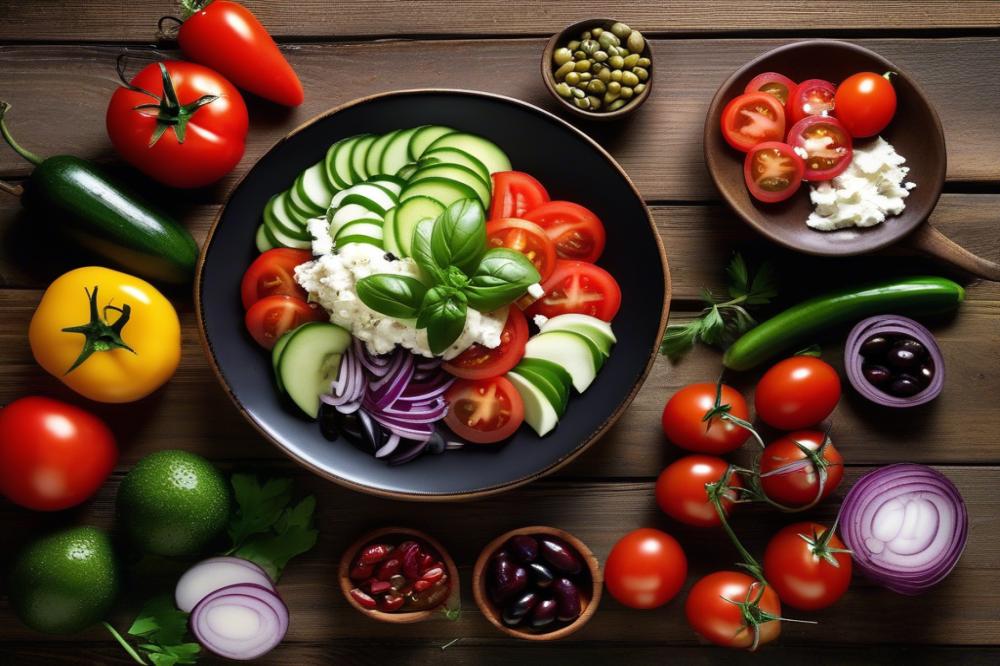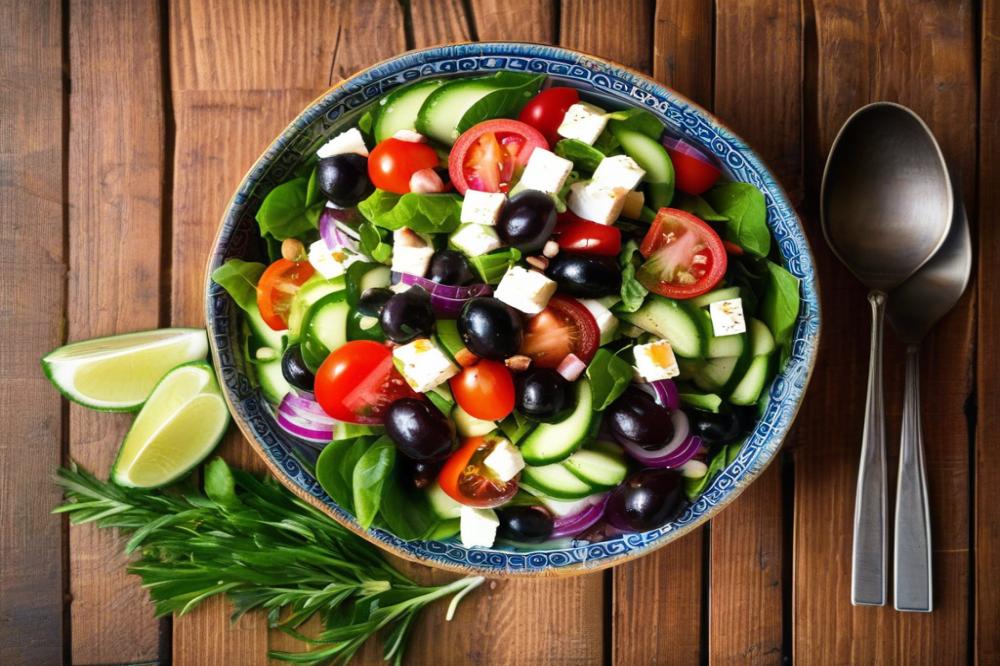Introduction
The Horiatiki salad is a classic dish that many people associate with Greek culture. This fresh and colorful salad showcases the best of traditional Mediterranean cuisine. It often features a delightful mix of vegetables, feta cheese, and olives. Each ingredient plays a vital role in its overall flavor and character. The simplicity of the recipe highlights the quality of the ingredients, which must be at their freshest.
Using fresh ingredients is essential in traditional recipes like this one. When vegetables are picked at their peak, they provide unmatched taste and nutrition. A Horiatiki salad typically includes tomatoes, cucumbers, and bell peppers. The crispness of these vegetables makes the dish especially appealing in the warm months. This healthy summer dish can become a favorite part of any meal.
Moreover, Mediterranean meals often emphasize fresh flavors and healthy choices. Olive oil acts as the perfect dressing, accentuating the salad’s natural tastes. With the addition of tangy feta cheese and briny olives, diners receive a balance of flavors and textures. Not only is this salad delicious, but it also represents a way of life rooted in fresh, wholesome ingredients. Enjoying a Greek salad is more than just a meal; it’s an experience connected to family and heritage.
Horiatiki Salad: Core Ingredients and Their Nutritional Benefits

This traditional recipe for Greek salad is packed with not only flavor but also a wealth of nutrition. Each ingredient brings something special to the dish.
List of Ingredients with Measurements
- Ripe tomatoes (2 medium)
- Cucumbers (1 large)
- Red onion (1 small)
- Bell pepper (1 medium, any color)
- Kalamata olives (1 cup)
- Feta cheese (200 grams)
- Extra virgin olive oil (3 tablespoons)
- Red wine vinegar (1 tablespoon)
- Dried oregano (1 teaspoon)
- Salt and pepper to taste
Nutritional Information for Each Ingredient
Ripe tomatoes are rich in vitamins A and C, as well as antioxidants. They add a juicy texture and a tangy flavor. Cucumbers contribute hydration and provide fiber. Their mild taste balances the salad. Red onions are not only crunchy but also packed with vitamins. They offer a distinct bite that enhances flavor. Bell peppers are filled with vitamin C and antioxidants, making them a colorful addition.
Kalamata olives are a source of healthy fats, which are great for heart health. Feta cheese adds a creamy element while supplying protein and calcium. Extra virgin olive oil is loaded with monounsaturated fats, beneficial for your heart. It also has antioxidants that can reduce inflammation. Red wine vinegar offers a low-calorie way to enhance flavor without excess fat.
Benefits of Consuming Fresh Vegetables, Olive Oil, and Feta
Eating these fresh vegetables provides essential vitamins and minerals vital for overall health. They support your immune system and keep you energized. Olive oil is not just tasty; it’s a staple of the Mediterranean diet known for promoting longevity and heart health. Feta cheese adds flavor, but it also offers protein necessary for muscle repair. Including olives ensures you get healthy fats that improve cholesterol levels. This summer dish not only pleases the palate but also nourishes the body.
Preparation Method for Horiatiki Salad

Making a delicious Horiatiki salad is simple and rewarding. Follow these step-by-step instructions to create this traditional Mediterranean dish.
Washing and Chopping Vegetables
Begin with fresh vegetables. Rinse them thoroughly under cold water to remove any dirt. Essential ingredients include ripe tomatoes, crisp cucumbers, red onions, and bell peppers. Dice the tomatoes into bite-sized pieces. Slice cucumbers into rounds. Cut onions into thin rings, and chop bell peppers into squares. Having colorful and vibrant vegetables will enhance both the look and taste of your salad.
Assembling the Salad in a Bowl
Once your vegetables are prepped, gather a large salad bowl. Start by placing the chopped tomatoes at the bottom. Layer the cucumbers, red onions, and bell peppers on top. Aim for a beautiful presentation; this adds to the enjoyment of the dish. When guests see your creation, they’ll be enticed to dig in.
Adding Olives and Feta Cheese
Incorporate olives for that authentic flavor. Kalamata olives work best, but any type can be used. Toss them over the vegetable mixture. Next, crumble feta cheese over everything. This tangy dairy product adds creaminess and complements the fresh ingredients perfectly.
Drizzling with Olive Oil and Vinegar
Now, it’s time to dress your salad. Pour a generous amount of high-quality olive oil over the top. Add a splash of red wine vinegar for acidity. This combination enhances the salad’s taste and brings the Mediterranean essence to your meal.
Seasoning with Oregano, Salt, and Pepper
Sprinkle dried oregano over the salad for an aromatic touch. Add salt and pepper to taste. These simple seasonings elevate the flavors, making your dish truly irresistible.
Tips for Ensuring Freshness and Taste
To keep your salad fresh, use seasonal vegetables whenever possible. Fresh ingredients make all the difference in flavor. If you can, prepare the salad just before serving to maintain crispness. A chilled salad bowl can also help keep the salad cool and refreshing on hot summer days.
Serving Suggestions for a Traditional Experience
When it comes to serving, consider offering crusty bread on the side. This addition allows everyone to enjoy dipping into their salad. For a true Mediterranean experience, pair the dish with grilled meats or seafood. Sharing this recipe with friends and family will surely make for a memorable meal together.
Variations and Alternative Ingredients

Traditional recipes for Horiatiki salad vary by region. You might encounter local twists that change the flavor and texture. In some areas, the addition of hot peppers adds a spicy kick, while others prefer to include various herbs like dill or mint for freshness. Each twist brings something special to this Mediterranean classic.
Choosing seasonal vegetables can also be a game-changer. Instead of relying solely on the basic tomato and cucumber, consider adding zucchini, bell peppers, or radishes. These vegetables not only enhance taste but also provide a vibrant array of colors and nutrients. Local options are often fresher, making your dish even more appealing.
Have you thought about incorporating unexpected ingredients? Addition of ingredients like capers introduces a briny flavor that complements the salad beautifully. Even avocados can be a delightful twist; their creamy texture pairs nicely with the crispness of the other vegetables. This versatility makes the salad adaptable and fun to prepare.
For those with dietary preferences, modifications can be easily made. A vegan version can simply skip the feta cheese, ensuring the salad remains full of flavor without animal products. You can use just olive oil and vinegar to dress it; they provide the essential Mediterranean taste. Gluten-free diets won’t miss a beat, as every ingredient in the salad fits perfectly into that category.
Revisiting the traditional elements can lead to interesting flavors and healthier options. Each person can craft their unique version of this summer dish. With a little creativity and awareness of what’s fresh and available, Horiatiki salad can become a favorite for everyone.
Cultural Significance and Serving Ideas

In Greek culture, the Horiatiki salad holds a special place. This traditional dish reflects the Mediterranean lifestyle and emphasizes fresh, healthy ingredients. Vibrant vegetables come together harmoniously, bringing color and nutrition to the table. Feta cheese and olives add unique flavors, enhancing the overall experience. It’s not just a meal but a celebration of local produce and culinary heritage.
Common Occasions for Serving This Salad
People often enjoy the salad during family gatherings, festive holidays, or simple weeknight dinners. Summer is particularly popular for this dish. When the weather is warm, it provides a refreshing and light option. Greek families frequently prepare it for barbecues and beach picnics, where everyone gathers to share food and stories.
Pairing with Traditional Greek Dishes
This salad complements many traditional Greek meals beautifully. It can balance the rich flavors of grilled meats, making a perfect side dish for souvlaki or moussaka. Served alongside warm pita bread, it becomes an irresistible addition to any meal. Keep in mind that the combination of flavors enhances the entire dining experience.
Centerpiece for Summer Gatherings and Picnics
During the summer, consider making the salad the centerpiece of your gatherings. Its vibrant colors and fresh ingredients are visually appealing. Guests appreciate its healthy nature, especially on hot days. Pack it up for a picnic, and it remains delightful even when served at room temperature. This dish transforms any occasion into a memorable feast.
Final Thoughts on Horiatiki Salad
Freshness and simplicity define the essence of a traditional Greek salad. Each ingredient brings out vibrant flavors that dance on the palate. The crispy vegetables, rich feta, and fragrant olives create a delightful combination. By relying on seasonal produce, this dish showcases the best of what nature offers. Enjoying a Horiatiki salad is like savoring a piece of Greek heritage.
Many people should consider trying this recipe. Experience the joy of making something so uncomplicated yet satisfying. When you prepare it at home, you create a connection to a time-honored culinary tradition. It’s a chance to appreciate the cultures and histories behind the food we eat.
Health benefits also accompany this delightful meal. The ingredients are packed with nutrients, making it a perfect choice for anyone seeking a balanced diet. Following a Mediterranean lifestyle is not just about food; it’s a way of life that emphasizes enjoyment and well-being. Give this salad a try and bring a taste of Greece to your kitchen. You won’t regret diving into such a flavorful experience.



